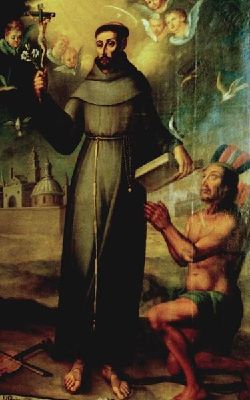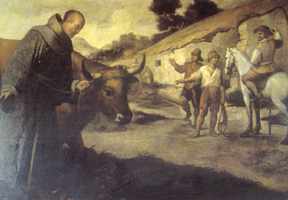Saint Francis Solano
| Francis Solanus | |
|---|---|
Francis Solanus with an Incan (Anonymous, c. 1588) | |
| Wonder Worker of the New World | |
| Born | 10 March 1549 in Andalusia, Spain |
| Died | 14 July 1610 in Lima, Perú |
| Venerated in | Roman Catholic Church |
| Beatified | 20 June 1675
by Pope Clement X |
| Canonized | 27 December 1726
by Pope Benedict XIII |
| Feast | 14 July |
| Patronage | Argentina; Bolivia; Chile; Paraguay; Perú |
Francis Solanus (Spanish: Francisco Solano) (10 March 1549 – 14 July 1610) was a Spanish missionary in South America, belonging to of the Order of Friars Minor (the Franciscans).
Biography
Francis Solanus was born in Montilla, in the Diocese of Córdoba, Spain. He had noble parents named Mateo Sanchez Solano and Anna Ximenes, and his mother reportedly consecrated him to Sanint Francis of Assisi while her child was still in the womb. His parents gave him a strongly religious upbringing and education.
When Francis turned 20 years old, he joined the Franciscan Order at Montilla. He became a priest seven years later in 1576. He was an eloquent preacher, but also spent a good deal of time in silent contemplation. During the plague of 1583 at Granada, he ministered heroically to the sick, a sacrifice which resulted in his be affected by the disease himself, from which he made a remarkable rapid recovery. His ministry, even in the midst of suffering, was a joyous one, and he was known to sing and dance ecstatically before the image of the Madonna and child, exclaiming, "Look at how well treated the Child Jesus is in the arms of Our Lady. That is how He lived on earth! Let’s be happy!”
In 1589, later he was sent by his superiors to the convent of Arifazza as master of novices. He soon chosen by Father Balthazar Navarro to join an missionary expedition to the Americas. They said first to many Panama, then crossed the isthmus to the Pacific, boarded another ship for Peru.
They encountered a bad storm, however, and the ship's captain ordered her to be abandoned, leaving on board a cargo of African slaves, for whom there was no room in the ship's single lifeboat. Francis, who had been instructing the slaves in the Christian faith, refused to leave them. With the ship breaking up, Francis gathered the men around him and baptized them. Almost immediately, the ship broke asunder and several of the men were swept away. The rest of the hull had lodged firmly around, and there Francis remain with his flock of newly-baptized slaves for three days. When the storm finally abated, the lifeboat returned to rescued the survivors, who eventually made their way to Lima.
For 20 years Francis worked at evangelizing the vast regions of Tucuman (present day northwestern Argentina) and Paraguay. He had a skill for languages and succeeded at learning many of the regions' native tongues in a fairly short period. It is said that he had the gift of tongues and also address tribes of different tongues in one language and yet be understood by them all. Being a musician as well, Francis also played the lute or the violin frequently for the natives, which helped them relate better to him. He was noted for singing hymns to to the Virgin Mary before her altar while playing the lute. Although joyful in his demeanor, he was also an ascetic who fasted often and engaged in frequent acts of penance. Like his namesake, Francis could reportedly communicate with the animal world and was said to have commanded a swarm of grasshoppers to leave a field which a native tribe had recently planted. He was extremely careful about his chastity, and had a rule that women could not come within a hundred paces of his personal dwelling.
After his ministry in Tucuman, Francis was elected to serve as the guardian of the Franciscan convent in Lima, Peru, around 1601. He also oversaw the convents of his order in Tucuman and Paraguay.[1] In Lima, he preached against the corruption of the colonists, called them to repentance, and worked to protect the indigenous peoples from oppression.
In 1610 Francis reportedly predicted the devastating 1618 earthquake of Trujillo, Peru. He is also said to have foretold his own death, which occurred in 1610 at Lima. Remarkably, he reportedly died at the moment of the consecration of the Eucharist, his last words being "Glory to God."
St. Francis Solano was beatified by Pope Clement X in 1675, and canonized by Pope Benedict XIII in 1726. His feast is kept throughout the Franciscan Order on July 24. ---?????? His feast day is July 13th.
Legacy
Saint Francis became especially popular among the Spanish Franciscans who worked in the Americas. On of the missions established by the Franciscan friars in California bears his name, established in 1830.
External links
- Francis Solano at Patron saints Index
- St. Francis Solano at "Saints Alive"
- (Spanish) San Francisco Solano
Credits
New World Encyclopedia writers and editors rewrote and completed the Wikipedia article in accordance with New World Encyclopedia standards. This article abides by terms of the Creative Commons CC-by-sa 3.0 License (CC-by-sa), which may be used and disseminated with proper attribution. Credit is due under the terms of this license that can reference both the New World Encyclopedia contributors and the selfless volunteer contributors of the Wikimedia Foundation. To cite this article click here for a list of acceptable citing formats.The history of earlier contributions by wikipedians is accessible to researchers here:
The history of this article since it was imported to New World Encyclopedia:
Note: Some restrictions may apply to use of individual images which are separately licensed.
- ↑ Among friars the names of their established are reversed from the norm. Thus a group of men live in what is called a convent, while women live in a monastery.


